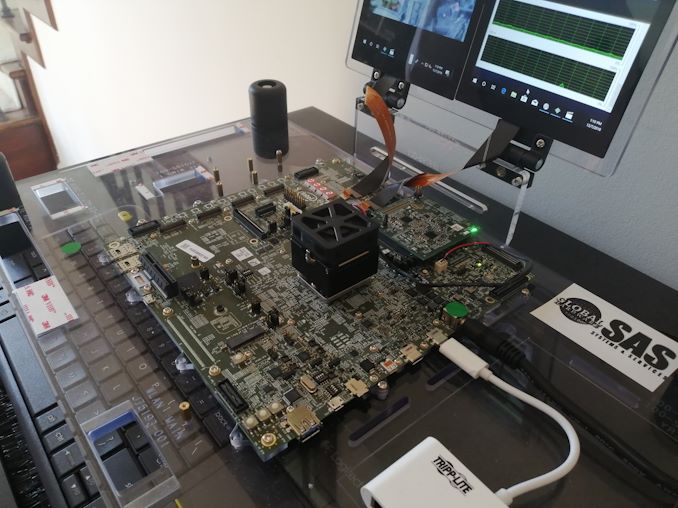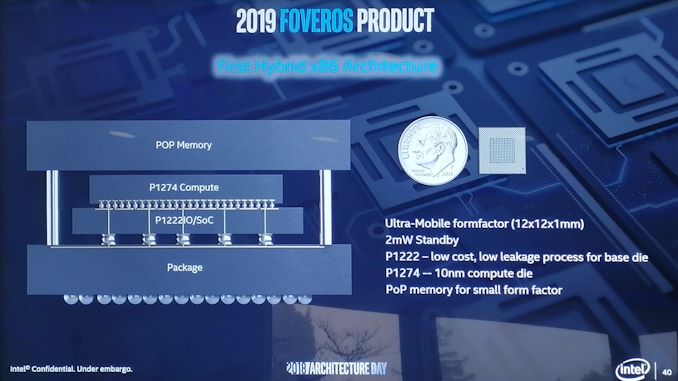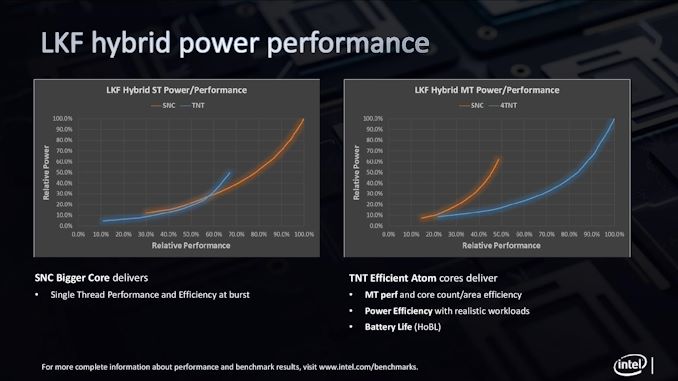Intel Discloses Lakefield CPUs Specifications: 64 Execution Units, up to 3.0 GHz, 7 W
by Dr. Ian Cutress on June 10, 2020 11:00 AM EST
Over the past 12 months, Intel has slowly started to disclose information about its first hybrid x86 platform, Lakefield. This new processor combines one ‘big’ CPU core with four ‘small’ CPU cores, along with a hefty chunk of graphics, with Intel setting out to deliver a new computing form factor. Highlights for this processor include its small footprint, due to new 3D stacking ‘Foveros’ technology, as well as its low standby SoC power, as low as 2.5 mW, which Intel states is 91% lower than previous low power Intel processors. Today’s announcement comes in two parts: first, the specifications.
Intel will debut these two SKUs in its first generation of Lakefield. These CPUs will find homes in premium, always-connected laptops, such as the Samsung Galaxy Book S expected in markets this month, the Lenovo ThinkPad X1 Fold, coming later this year, and in the Microsoft Surface Book Neo.
Both SKUs will feature one big ‘Sunny Cove’ CPU core, along with four little ‘Tremont’ Atom CPU cores. Both sets of cores will have access to a 4 MB last level cache, although Intel has not yet disclosed what sort of cache this is.
Meanwhile on the graphics front, Intel is integrating a Gen11 GPU with 64 execution units, the same number of EUs as on Intel's Ice Lake processors. Interestingly, the iGPU is clocked about half as high as usual for an Intel GPU, with clockspeeds peaking at just 500 MHz – suggesting that Intel is going wide and slow to increase graphics performance. Both CPUs will be rated for a TDP of 7 W.
| Intel Lakefield Processors | ||||||||
| AnandTech | Cores | Base Freq |
1C Turbo |
nT Turbo |
Gen11 IGP |
IGP Freq |
DRAM LP4 |
TDP |
| i5-L16G7 | 1+4 | 1400 | 3000 | 1800 | 64 EUs | 500 | 4267 | 7 W |
| i3-L13G4 | 1+4 | 800 | 2800 | 1300 | 48 EUs | 500 | 4267 | 7 W |
Intel confirmed to us that the base frequency is the unified frequency across all five cores, and the single core turbo frequency applies only to the big Sunny Cove core. Support for LPDDR4X-4266 is a notch above the memory controller in Ice Lake, which only runs at LPDDR4X-3733, and the memory speed will likely be a big boost to performance.
In order to enable these processors in a small 12mm x 12mm footprint, Intel is using its 3D stacking technology, called Foveros. This means that the logic areas of the chip, such as the cores and the graphics, sit on a 10+ nm die, while the IO parts of the chip are on a 22nm silicon die, and they are stacked together. In order to make the connections work, Intel has enabled 50 micron connection pads between the two silicon halves, along with power-focused TSVs (through silicon vias) in order to power the cores on the top layer.
Intel lists the TDP for these chips at 7 W, although the company has not disclosed the turbo power limits for the chip. As mentioned above, Intel hasn’t disclosed how the cache works. In the initial diagrams, we were shown that PoP memory would be added on top, and while Intel hasn't offered further details there, we know from last month's Samsung Galaxy Book S reveal that there will be (at least) 8GB SKUs using LPDDR4X.
We have big questions as to how each of the cores will work, given that by default they support different instruction sets – Intel hasn’t provided information on this at this time. Intel has stated that the scheduling of the threads on the different parts of the CPU will occur based on hardware-guided OS scheduling, although again Intel hasn’t gone into the details of its hardware tracking and enablement on how this is done. In the demos we have seen, Lakefield will use the Tremont cores for almost everything, and only call on the Sunny Cove core for user-experience type of interactions, such as typing or interacting with the screen.
Intel is planning a post-announcement briefing for press to ask questions, which means that this announcement is coming in two parts. This is the information we’re being given beforehand, and we will update you with the details from the post-announcement briefing. As part of this process, we’ve exclaimed to Intel how this way around of presenting details to the press is frustrating – firstly for readers, as you all will have to come back if you want to find out what more Intel tells us later today, but secondly for us, as press, who will have to scramble to jump on the details and decide whether to write fast and miss details, or write slow and miss the wave of traffic.
One thing we can confirm in advance – the Sunny Cove does not appear to be AVX-512 enabled. Intel’s initial press release states that AI workloads occur on the CPU; given the extra power draw required for AVX-512, this is probably a good thing.
More information out of Intel’s post-announcement press-briefing will come later today.














78 Comments
View All Comments
PeachNCream - Wednesday, June 10, 2020 - link
It really is design dependent. I just dislike feeling a device emit heat and when you're peak is 7W there isn't a good way to sustain that sort of load for multiple hours and not expect to feel a noteworthy warm spot on a laptop. 4W makes a lot more sense with a large, wide heat spreader plate and would give the end user a much better result in a ventilation-free chassis like you find on HP Stream laptops. Besides that, there is not much reason for the big core to begin with. Most compute tasks can be accomplished pretty well on Atom cores. I'm using a Celeron N2840 which is a dual core Bay Trail (mind you with 8GB thanks to a user-replacable DIMM and a 1TB SATA drive) as my primary laptop. Its passively cooled and while it handles full load, I would prefer it not feel warm to the touch when I put that CPU to use. On the same note, I don't feel like there is a shortage of processor power or much need for an increase in performance that a bigger core would offer. Four more modern small cores would be more than good enough and maybe twice the iGPU performance so it can handle 720p60 content off Youtube. The only time I really feel it might be a tad slow is when I'm putting together a video in Kdenlive. Playback before rendering is slow and rendering jobs take a little while to complete, but other workloads like running VMs in VirtualBox or trivial stuff like gaming (what works under Linux anyhow) don't really expose much performance weakness yet, but it does make my legs feel warm which is annoying and the TDP for that Bay Trail chip is 7.5W according to ARK.brantron - Wednesday, June 10, 2020 - link
You're not going to see 7 watts sustained at all, certainly not for hours lol.My archaic Skylake dual-core is using 2 watts between the CPU cores and GPU, combined, and I have 10 tabs open, visual studio, and two games minimized.
These new CPUs have all sorts of power reducing sorcery, in addition to a peak CPU voltage likely under 1.0v. They'll be fine.
lmcd - Wednesday, June 10, 2020 - link
The bigger Sunny Cove core should help with light gaming and "bursty" activity. From my understanding, Atom cores never got any sort of "dynamic overclock" burst mode, and the additions to include that feature would substantially increase the size of the core.Irata - Thursday, June 11, 2020 - link
Judging by Ian's Twitter posts, 7W does not seem to be the max power consumption, but rather base.IBM760XL - Wednesday, June 10, 2020 - link
Agreed, 7W is a good target. My passively cooled laptop (and namesake on this forum) runs a Pentium MMX in that power bracket, and while it does get toasty if I run SuperPi on it for too long, for common tasks like creating documents in Word or Visio, it stays at quite reasonable temperatures.Admittedly most laptops are thinner nowadays, so the heat is probably more noticeable.
lmcd - Wednesday, June 10, 2020 - link
I feel like heatsink designs have gotten more clever, if not also more efficient. As long as you have a full laptop base to use as a heatsink (and not just a rubber-coated tablet back), 7W in a thinner form factor is totally possible.JayNor - Wednesday, June 10, 2020 - link
Intel introduced the snow ridge/p5900 family earlier this year which has 8 to 24 Tremont cores.tkSteveFOX - Wednesday, June 10, 2020 - link
The Tremont cores are a joke and with just one Sunny Cove core, I really don't see what Intel are aiming at in putting all of those iGPU cores.A more sensible solution would have been 2 Sunny Cove + 4 Tremnont cores and 32 and max 48 iGPU cores.
Tabalan - Wednesday, June 10, 2020 - link
Well, according to Intel graphs these joke Tremont cores offer 65-70% of Sunny Cove performance. I'd say its damn solid performance for Atom core. Also, 2 SNC + 4 TNT would throttle much harder during CPU intensive tasks.lmcd - Wednesday, June 10, 2020 - link
Also would jump die size substantially. Not worth the tradeoff I'd imagine. For a stacking design, changing the dimensions could be fatal. Part of the point is how tiny this package is! Add UFS, audio circuitry, I/O and wireless and that's the whole board.Honestly the external LTE modem defeats the purpose of this from my vantage. I'd rather the space go toward an extra port or something.